Digitised @SLQ - Beautiful Queensland from a railway carriage window
By Simon Miller, Library Technician, State Library of Queensland | 20 February 2015
On the 8th of December 1924 the opening of the Daradgee Railway Bridge finally completed the North Coast Railway linking Brisbane and Cairns. The first section of the line connecting Gympie to Maryborough had been opened on the 6th of August 1881 and other pieces of the line were built in isolated sections as need dictated while the main efforts in rail building proceeded inland from various ports along the coast. The North Coast Railway Act 1910 finally committed the government to linking the various sections to establish a continuous line from Brisbane to Cairns and the final link was the completion of the Daradgee Railway Bridge over the North Johnstone River. The bridge and the completed line was opened with great fanfare by Premier Ted Theodore.
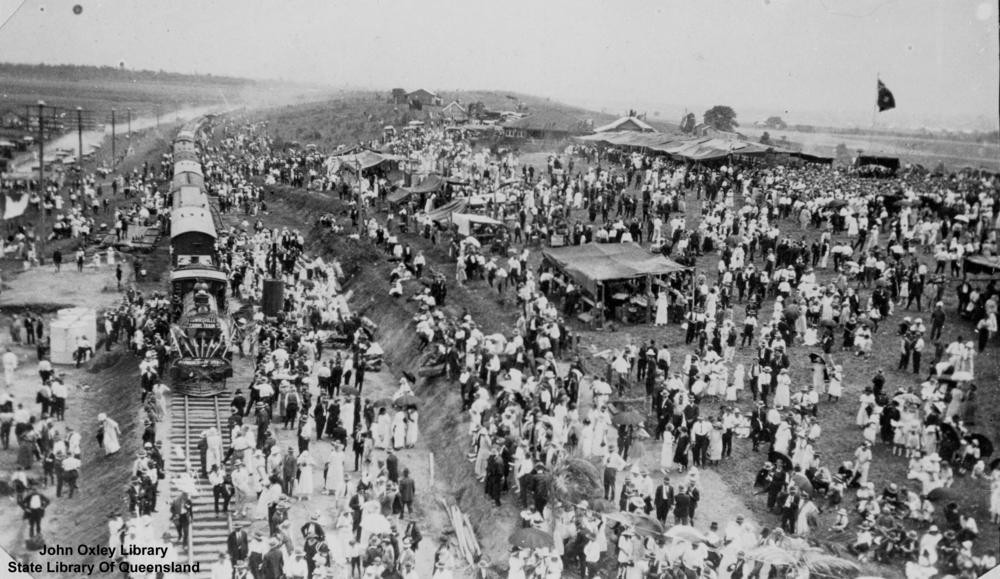
Official opening of the Daradgee Bridge over the Johnstone River
Taking advantage of the new line, Queensland Rail published a substantial brochure highlighting the new possibility of travelling from Melbourne or Sydney all the way to Cairns by rail. This publication Beautiful Queensland : the land of variety and the holiday-makers happy hunting ground was published under the authority of the Queensland, New South Wales and Victorian Railway Commissioners in 1926. It has been digitised as part of a collection of heritage tourism booklets which you can read about on this earlier blog story.
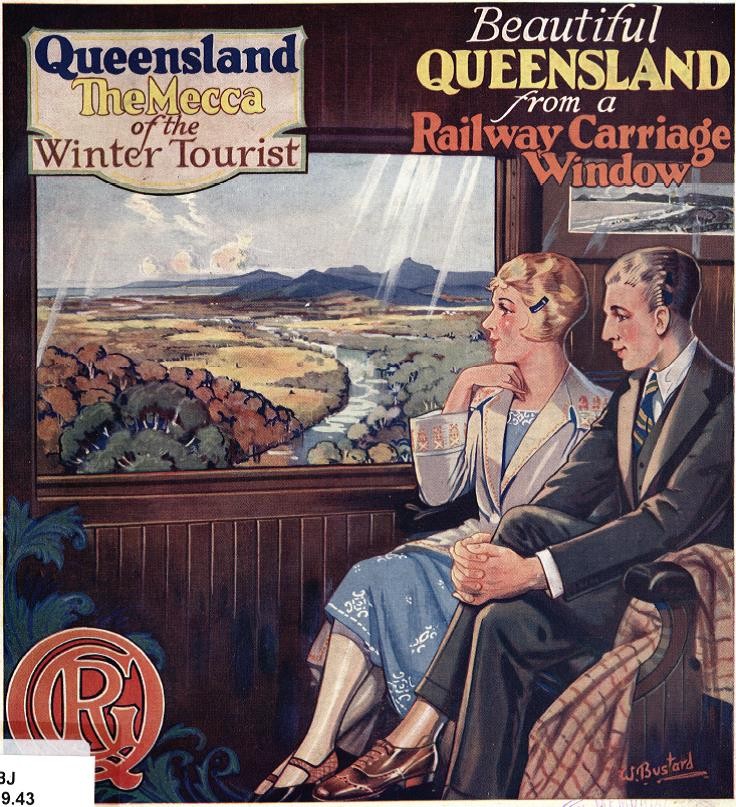
Beautiful Queensland: the land of variety and the holiday-maker's happy hunting ground.
After the exhortation "Sunny Queensland calls!" the pamphlet introduces its main purpose and wastes no time in spruiking the charms of a Queensland holiday.
The completion of the Coastal Railway from Brisbane to Cairns has established direct railway communication between North Queensland, New South Wales and Victoria. Fast trains equipped with sleeping cars and replete with every convenience for long-distance travel maintain a regular service between the Southern Capitals and Queensland, and bring the tropical beauties of the famous Cairns District within easy reach of Sydney and Melbourne.
With clear blue skies, bright sunny days, and an invigorating climate, Queensland stands pre-eminent as the ideal winter resort for the tourist and convalescent. Her beauty is as varied as it is entrancing. Greeted by the peaceful scenery of the apple orchards of the Southern Highlands, the traveller journeys across the wheatfields of the famous Darling Downs, descends the magnificent Main Range, Passes over the fertile Valley of the Lockyer into Brisbane, and so on through the noted banana and pineapple lands of the North Coast to stretches of cattle and dairying country and the wide canefields of the North, until the tropical Wonderland of the Cairns District comes as a fitting finale. Here the Barron Gorge crowns the journey with a grandeur indescribable, and luxuriant tropical vegetation provides and exotic setting for shimmering seas, crystal-clear rivers, sparkling lakes, and beautiful waterfalls.
After detailing the timetable for a journey from Melbourne or Sydney the pamphlet takes up a detailed description of the journey beginning at the border town of Wallan-garra where the traveler was compelled to change train at the transition to the narrow gauge of the Queensland railways. The Queensland government had decided at the outset of railway construction in the state to opt for the cheaper narrow gauge, reasoning that it would be better to travel further at a slower speed than to build with a wider gauge that would have allowed faster trains. This decision allowed a rapid expansion of railways in Queensland from the opening of the first line 150 years ago in 1865. Travellers were required to stop at Wallan-garra to change trains until the completion of the standard gauge railway to Brisbane in 1930 after which many passengers continued to travel via Wallan-garra as an alternative route although few were greeted with as much ceremony as The Duke of Gloucester seen here arriving in Queensland at Wallan-garra Station in 1934.
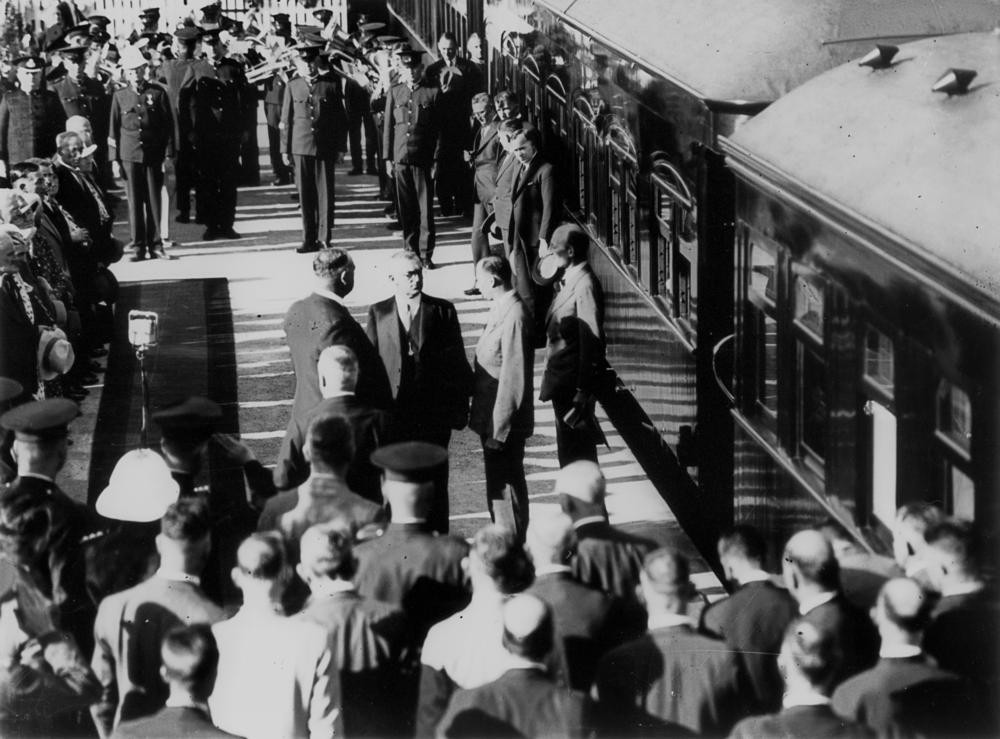
Official welcoming party for The Duke of Gloucester on entering Queensland 1934
The fifty pages of this informative pamphlet are packed with descriptions and information about Queensland from the border through the Darling Downs to Brisbane and northwards along the coast. This excerpt describes the country around the rapidly growing town of Tully.
Beautiful patches of tropical jungle are passed between Bilyana and Tully, and in the clearings young cane is growing among the charred timber. Logs and teams in station yards provide us with the first glimpse of North Queensland’s untold wealth of cabinet timbers. Tully is the latest addition to the Northern sugar-producing centers, and promises a great future. The new Government mill is the finest in Australia, and has a milling capacity of 7,000 tons of cane per week. A township has grown about the mill overnight, and the rapid development of the district is remarkable. Many miles of tramways have been laid, substantial buildings built, roads formed, and great tracts of dense scrub cleared for sugar farms. Sugar is now all that matters, and from Tully to Cairns the railway runs through interminable seas of cane. What has been incidental to our journey now becomes all-important.
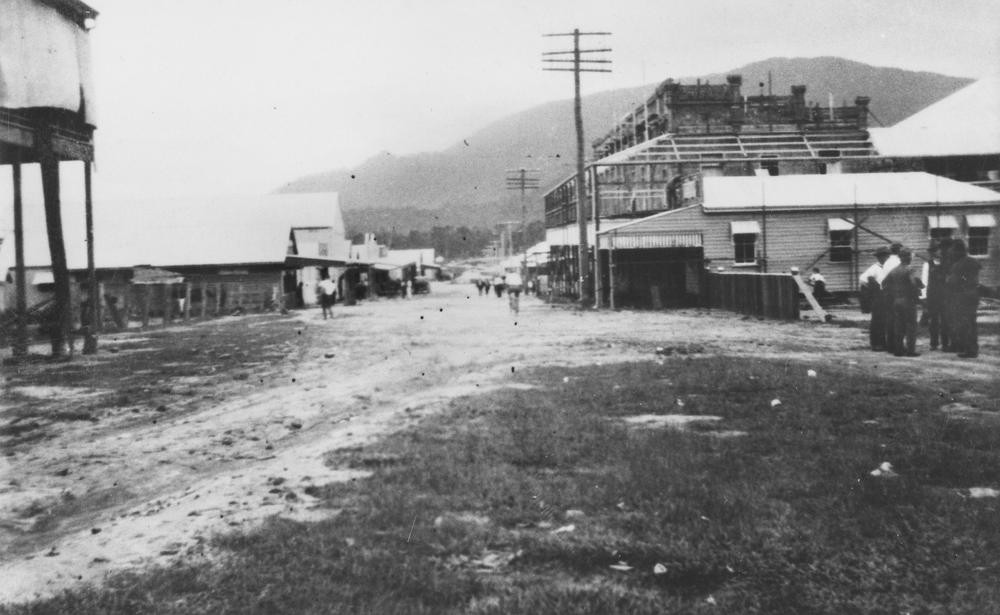
Butler Street, Tully, Queensland, 1926
Eventually the train arrives in Cairns: As darkness falls the train draws quietly into the Northern terminus, and gathering out belongings we are soon refreshed and ensconced on the deep veranda of a tropical hotel, there to be lulled to sleep by the silken rustle of the coco-palms and the softly lapping waters of a Northern sea. This is not the end of the adventure however, as the pamphlet continues with a description of the journey up the range to Kuranda, still a popular trip for tourists, and onward as far as Ravenshoe on the Atherton Tableland. The highlight of the journey being the spectacular Barron Falls.
Rounding Red Bluff the scene perhaps is the finest on the journey. Bathed in sunlight, the Barron Valley far below presents an unforgetable picture. Redlynch is clearly visible and Cairns lies almost hidden in the distance. The dull red squares and vivid greens of cultivated areas, the deeper greens of patches of scrub, the purple mountains far away and the silver thread of the Barron winding out to sea, provide a picture beautiful beyond words. We can only gaze in rapture as the winding of the track produces many variations of this wonderful view, and carry it away an imperishable memory. …
While the thunder of a mighty cataract grows louder and louder Lady Robinson’s Lookout comes into view, perched on giddy heights above the Devil’s Pool, followed by King O’Malley’s Chair, another favourite lookout close at hand ; but these are passed undeeded, for the roar of the Barron becomes all-subduing, all-compelling. Then with Barron Falls Station there suddenly bursts upon us the magnificent spectacle of millions of gallons of foaming, frothing, snowy water falling in wild disorder over a narrow ledge to depths unseen. It is the mighty Barron River, released from its tortuous path, plunging in uncontrollable fury over the precipice into a rock-strewn chasm more than 800 ft. below. No pen can describe or picture paint the wonder of the Falls, but the fortunate traveller who views this awe-inspiring handiwork of Nature never forgets the scene.
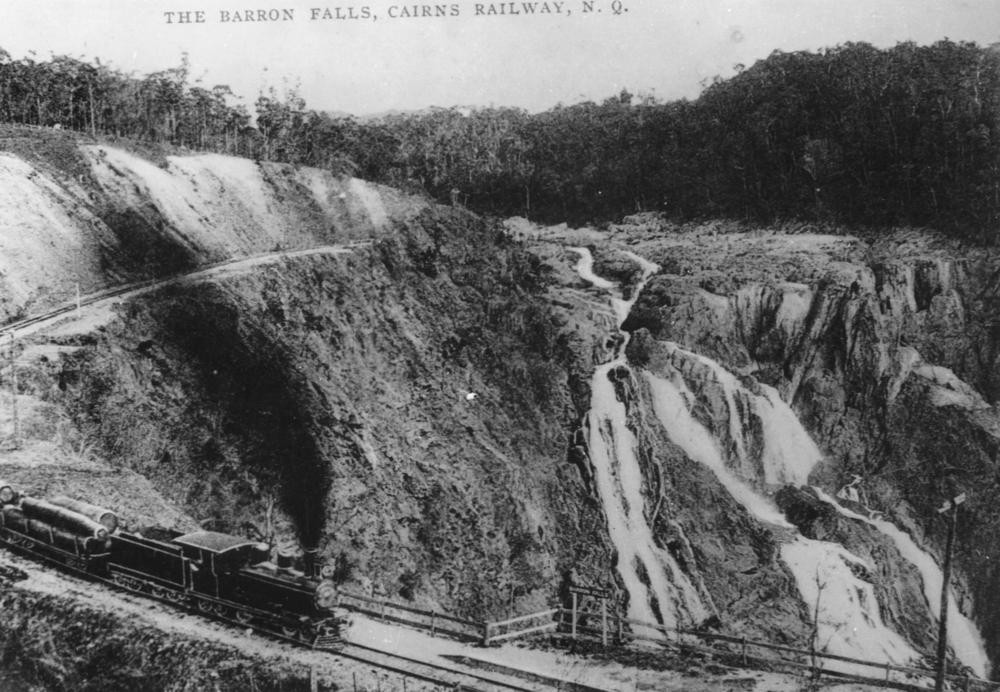
Approaching the Barron Falls railway station, ca. 1912
For comparison you can also view the 1929 version of the pamphlet featuring a waterfall on the cover or explore more of our digitised collection of pamphlets.
Simon Miller - Library Technician, State Library of Queensland
Comments
Your email address will not be published.
We welcome relevant, respectful comments.